Record numbers at SaltCon 2019!
Another super fun weekend of board gaming at SaltCon is in the books!
I look forward to SaltCon with high anticipation every year and it never disappoints.
And that’s exactly how I’m feeling again looking back on last weekend of fun board gaming with friends and strangers.
SaltCon is our local board game convention that rolls around the first weekend of March. And like the previous years, it continues to hit record numbers.
For SaltCon 2019, more than 1,900 people came for the fun!
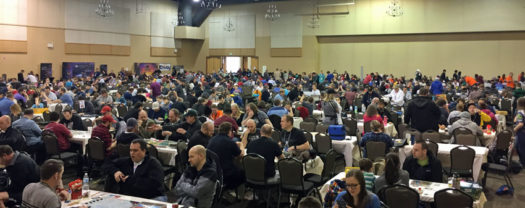
While the event runs for 4 days (Thursday-Sunday), I was able to be there from Thursday afternoon to Saturday afternoon. And I had fun every minute!
Since the location of the event is over an hour drive away from home, rather than drive back and forth each day, I book a hotel room and make it a fun getaway.
Plus, when I’m playing games until 2 am, it’s much easier to just make my way to a neighboring hotel to get a few hours of shut-eye before going at it again.
And now on to my quick thoughts on the 20 games I played…
Gizmos
One of the great parts of SaltCon is the dedicated space for Hot Games. This year, there were 15 tables set aside for games that are currently on so many people’s “want to play” lists. Each game has their dedicated table and SaltCon volunteers are on hand to teach every game. Since the Hot Games tables fill up quickly on Friday and Saturday, I took advantage of Thursday to get in on some of the hot games.
The first one of interest was Gizmos by CMON.
In Gizmos, players use four types of ‘energy’ marbles to construct and power up machines. There’s a cool 3D marble dispenser where players claim marbles to construct new additions to their works. New attachments can trigger chain reactions, letting players do even more on their turn. I really enjoyed figuring out which marbles to take when and which abilities to add to my growing machine.
Gizmos took about 30 minutes to play and was a great first game to get started with.
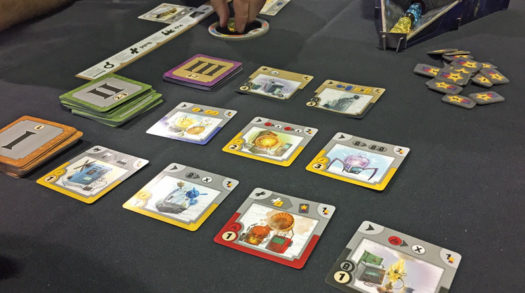
Crusaders: Thy Will be Done
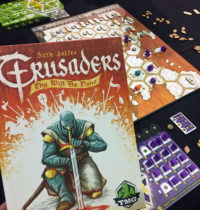
After Gizmos, the 3 other friends I was playing with and I simply moved over one table to play Crusaders: Thy Will Be Done by Tasty Minstrel Games.
Crusaders is a game where players move their knights across a map to building different types of buildings and spread their influence. The game uses a combination of rondel and mancala mechanisms. Each player has their own rondel, which controls their action choices during the game.
Players pick up all the pieces in one section to do that action. The amount of pieces they have in that section determines how much of that ability they can do. Then they drop off the pieces one by one to the next spaces in their circle.
Thus, players have to balance when to take which actions and how much to let each build up before using it. Players can also upgrade their action areas over the course of the game.
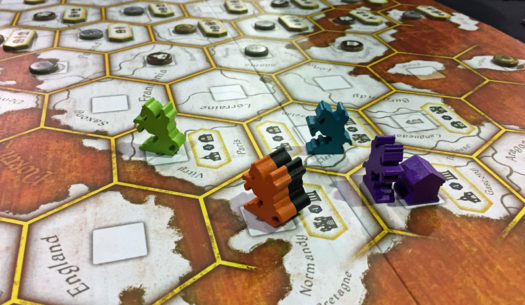
Architects of the West Kingdom
It just so happened that after we finished playing Crusaders, the hot game table next to us was vacant. So we moved over a table and dove into Architects of the West Kingdom by Renegade Game Studios.
Architects is in the same vein of a game as Raiders of the North Sea (which we recently reviewed). It’s a worker-placement game where player place workers in areas to take different actions. However, in Architects, players start with all their workers.
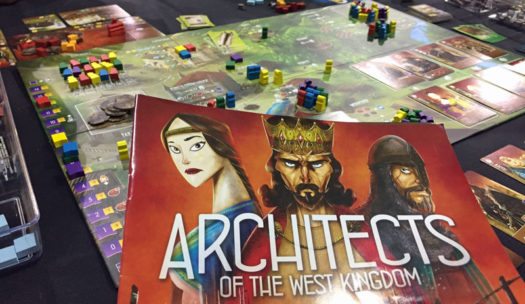
There are plenty of possible actions to take and many of them are more powerful as you add more workers to that area. The challenge though is that other players may capture your workers and leave you less powerful than before. The good news is that there are ways for players to get their workers back from the other players or from the Guardhouse where they may have been carted off to.
I’m still enamored with the artwork in this line of games and had a great time playing Architects.
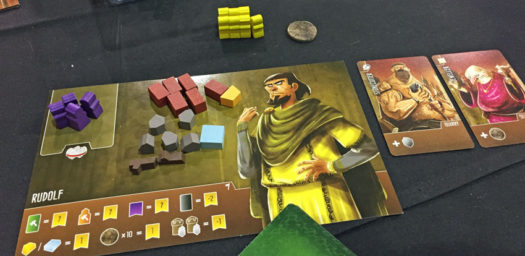
Barenpark
After taking a break to grab a bite to eat, I circled back with my friend, Dane, for a 2-player game of Barenpark.
Barenpark, by Lookout Games, is a game I’ve had on my “want to play” list ever since it was first published a couple years ago. Since it’s a tile-laying game, I was immediately interested because I thought it would be one my wife might like since she loves Patchwork and NMBR 9.
Dane had checked out a copy of Barenpark from the SaltCon Game Library (thousands of games to choose from) and I was very happy to see him reading the rules when I got back from my dinner break.
In Barenpark, players build their own animal park made up of polyominoes that are taken from a central board. The higher valued tiles are on top, so timing when you snag a tile makes a difference on the outcome. But if you want to score the piece at the end, you’ll have to place it in your park. So there’s more to consider as you grab the differently shaped tiles.
Barenpark is a quick game (especially with 2 players) and I enjoyed it so much, I had to play it again. Good thing Dane was accommodating and we went at it again. Maybe I should have stopped with my first game because I didn’t do as well in the second game.
Ok – who am I kidding. I really enjoyed Barenpark and would love to play it no matter what my final score turns out to be. (I guess it’s a good thing that I already had a copy on it’s way to my house…)
(See our full review of Barenpark.)
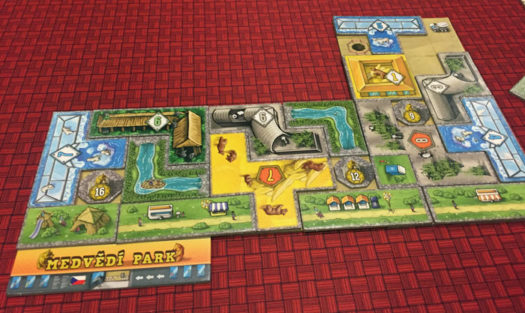
The Mind
Then Dane and I tried to see how much our brains were on the same wavelength by playing The Mind.
The Mind is a simple card game where players must play cards in ascending order. It’s played over a series of rounds where players each take a number of cards equal to the round. So in the first round, each player only has 1 card to play. In the 5th round, players each get 5 cards to play.
There aren’t any turns in the game and any player can play any card at any time. However, if the next card played is lower than a previous card played, you lose a life. Lose a set number of lives and you lose the game.
The big catch in the game however is that players can’t communicate at all!
So you have no idea what value cards the other players are holding. So you don’t know when to put down your lowest card.
In a 2-player game, the challenge is to successfully play to and complete level 12.
Dane and I were feeling pretty good about our game play, but we only made it to level 8 before we lost.
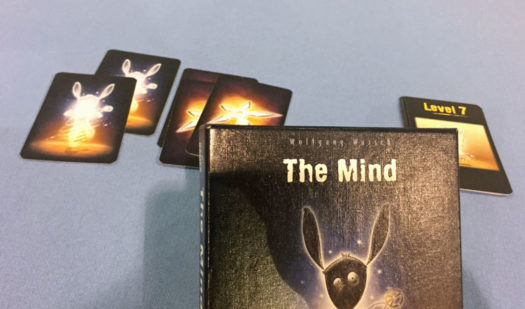
Lords of Vegas
The final game of the night was one I’d heard about for years but didn’t really have interest in playing — Lords of Vegas by Mayfair Games.
But one of the friends that I love playing games with each year at SaltCon had brought his copy and really wanted to play it. So we dove into buying casino properties in Las Vegas and rolling dice to test our luck and gain money.
The game has some pretty cool mechanics as players try to evaluate the odds of different casino properties. Yet, it’s also a game driven by luck. Of course, that’s also pretty fitting for the theme of the game.
I was leading for most of the game, swallowing up other casinos and having the upper hand at shared casinos. So when payouts were awarded, they fell my way. However, my luck ran out in the final round of the game as another player took control of every casino I was in by the pure luck of dice rolls. And I was surpassed for the final tally.
Overall, I had a fun time playing Lords of Vegas but was feeling a bit tired since it was now around 1:30 am.
So I headed to the hotel to get some rest.
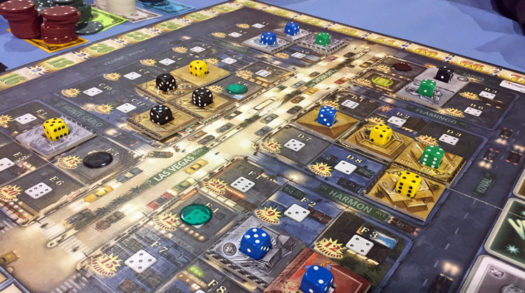
Coimbra
Friday morning we went straight to the Hot Games tables again before the crowds started. The first game we dove into was Coimbra. I’ve seen the name and box art pop up many times over the past few months on game review sites.
However, I hadn’t been tempted by it. But since the table was open and those I was with were interested, we gave it a go.
There’s a ton of things going on in Coimbra with a ton of ways to score points. I wasn’t overwhelmed by the amount, but in the end I felt like the game was trying to do way too much.
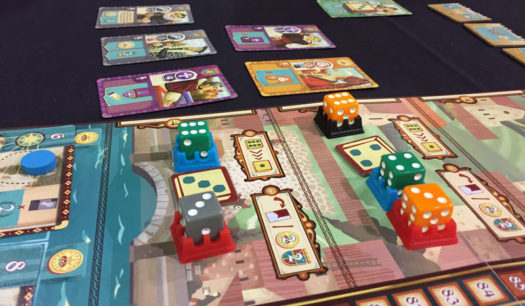
I really liked the dice rolling and drafting and the various options you could use the dice for. However, each decision was very layered. Between the color of dice, the pips on the dice, the locations still available, and the various things on each card of how to use them there was just too much to have a focus.
Our scores were in the 30’s and 40’s when the game ended. But after post-game scoring items, we finished the game ranged from 110 down to the 80’s. And when I score 20 additional points at the end of the game because of some small icons on the cards that I hadn’t even noticed when I purchased them, it tells me there’s an overkill on ways to score points.
So in the end, Coimbra isn’t a game for me.
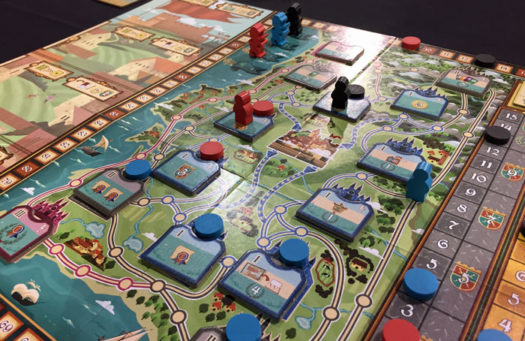
Gingerbread House
The next hot game we tackled was a quick one — Gingerbread House by Lookout Games.
It’s a tile-laying game where each player builds their own gingerbread house full of sweets to attract people and creatures to their house. As players place the domino-style tiles on their growing house, they claim the type of cookie token they’ve covered. Then they turn in sets of cookie tokens to claim cards (those attracted to the house) for points.
It’s a quick game as each player simply places a tile on their house and claims the tokens. If they have enough of the right kinds of tokens, they claim the cards. Then it’s on to the next player.
Before you know it, the game is over and you’re counting points.
It’s a light game that feels like a good fit for families. But in the end, I missed any player interaction. Sure, they’d take cards I had hoped to get but players can also reserve cards. So it mostly just came down to which tiles I placed and where. I found myself only focused on my house and doing my own thing.
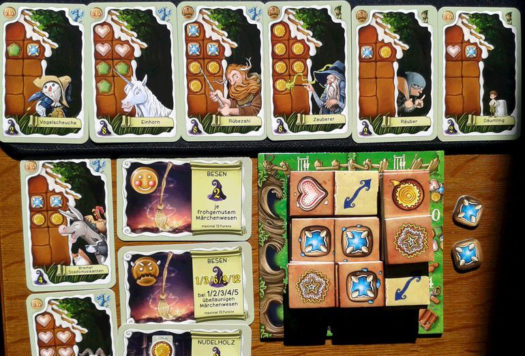
Wildlands
The next hot game we played was Wildlands by Osprey Games. One of the guys I was playing with owns a copy of Wildlands so we were able to dive into playing without the need for a friendly SaltCon volunteer.
One of the things I enjoyed about Wildlands is that every player gets their own unique set of characters with varied abilities. The goal is to capture crystals or take out opponent characters. Either of those activities earns you a point and you only need 4 points to win. So the game is a quick race to achieving those points.
It was a fun melee type game where your opponents can also help you out. For example, in our game, if it weren’t for another player eliminating another opponent’s characters, that other player would have won that round. Instead, play got around to me for another turn and I captured the crystal I needed for the win.
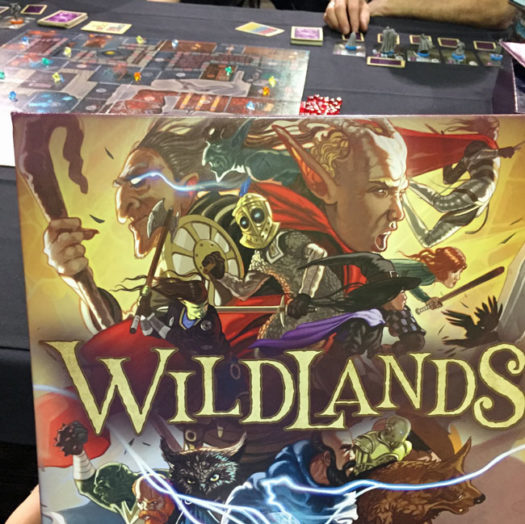
Champions of Midgard
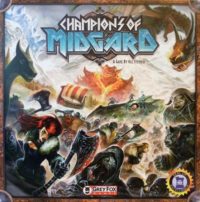
Next, Dane and I learned a game we’d both heard lots of good things about and had been curious about playing — Champions of Midgard by Grey Fox Games. We found the game in the Game Library and took to learning it ourselves for a 2-player game.
It’s a viking-themed, worker-placement board game with rolling dice for combat.
It would have been nice to have another person explain the game to us, but we also didn’t have trouble just reading through the rules ourselves to play. And we definitely weren’t alone in that way to approach a game. Many attendees do likewise — checking out a game from the library that they’re interested in and then reading through the rules on site to learn and play the game.
Spell Smashers
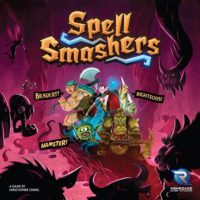
Another game we checked out of the game library and taught ourselves to play was Spell Smashers by Renegade Game Studios.
Spell Smashers is a word game where players build words using the letters on the cards in their hand. But rather than just spelling words, players are also competing to conquer different monsters in play.
And if that weren’t enough, players can also visit different locations on a main board to buy different tools to help them along the way.
While I still have an aversion to spelling games overall, I found the fantasy theme around a spelling game to be quite fun.
The Quacks of Quedlinburg
After a bit of a break to check out other areas of SaltCon and visit with more friends, I saw an opening at another hot game table — The Quacks of Quedlinburg by North Star Games.
Now, I had no idea where Quedlinburg was, not that it was a real place. But that hadn’t stopped me from being curious about this potion-making, bag-builder game and very anxious to give it a try.
In fact, Quacks was near the top of my “want to play” list going into SaltCon. And I’m so glad I did, because I really like it!
Quacks is like a deck-building game (Dominion, Thunderstone, Clank!), but instead of buying cards and adding them to your deck, players buy different tokens to add to their bag.
But it also has a push-your-luck element.
Each round players toss all their tokens in their bag and draw them out one at a time and stir them into their pot. The catch is that there are also bad ingredients in the bag. If you draw too many bad ingredients, your potion will spoil. So players must decide how long to keep pulling ingredients out of their bag. The can keep hoping for the good ones they’ve bought to come up, but the luck of the draw may say otherwise.
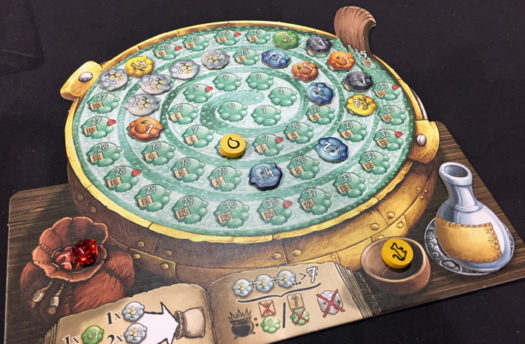
The trouble with Quacks is that it’s out of stock everywhere. So I’ll have to just put it on my list to check back on later this year.
See our full review of Quacks of Quedlinburg.
Kodama Duo
After dinner it was time to settle down with a few light games. The first game I pulled out with my friend Doug was a game I’d brought with me — Kodama Duo in Indie Boards and Cards.
Kodama Duo is a 2-player game where players build zen-like trees. Each branch card has different icons of “spirits” that players want to score points. The game has a fun I-split-you-choose mechanic. Three cards are placed face up each round. One player chooses how to divide the cards (2 cards in one set and a single card on its own). Then the other player choose which to take — either the 2 cards or the 1 card. The splitter gets what’s left.
In either case, both players only add one card to their growing tree. The player who took two cards must choose one to place and discard the other. But they also get to claim a spirit token of one of the spirit icons on the discarded card, which they can use to cover any other icon in their tree.
It’s a fun light game for two players and I was glad I brought it along.
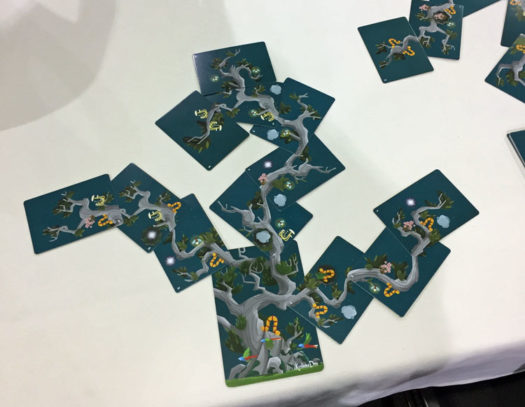
Tides of Time
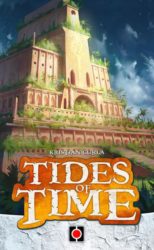
Doug and I then played a quick 2-player game of Tides of Time by Portal Games.
This is a really quick game where each player gets 5 cards, chooses one to keep and passes the rest to the other player. Then the same thing happens with the remaining 4 cards.
After all 5 cards have been played, players score their points from what’s stated on the cards they kept. Then they keep one card in play permanently and discard one from the game. Then they each draw 2 more cards so they’re back to 5 cards and round 2 begins.
Players then repeat this for round 3 and final scoring takes place.
While Tides of Time wasn’t a game I brought from home, it was a game I got in the SaltCon math trade. It’s a solid game that I’m happy to have in my game collection as a game can be played in under 10 minutes.
Dinosaur Tea Party
Every year I seek to bring along games to play that I think my SaltCon buddies wouldn’t have played before.
Such was the case with Dinosaur Tea Party by Restoration Games.
Since it’s become a family favorite deduction game, I was looking forward to introducing it to buddies at SaltCon.
If you want to see more about Dinosaur Tea Party, you can check out our review that we did in January.
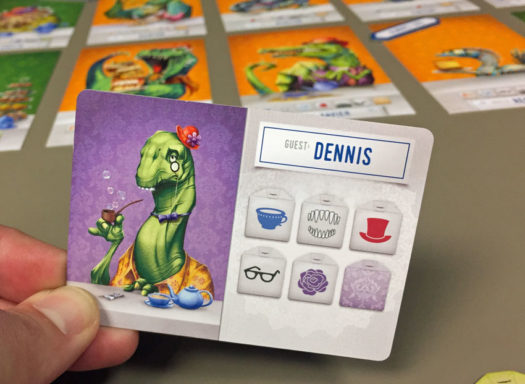
Topiary
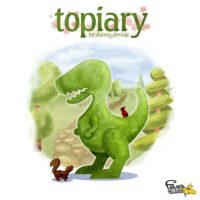
The next game I pulled from my bag was one I’d been wanting to play for months — Topiary.
Sometimes a cute-looking game can be quite cutthroat. Such is the case with Topiary by Renegade Game Studios.
In Topiary, players try to position their visitors on the outer edge of a topiary garden in order to give them the best view possible. Visitors can see the closest topiary sculpture to them and any behind that, in the same sight line, that are larger. Players also score bonus points for visitors who see multiple topiary sculptures of the same type.
Players start with a hand of 3 tiles and each turn place one of their visitors and remove a face down tile from the sight line of that visitor. Then they choose a tile from their hand to place face up in that location.
As more visitors are placed, it’s obvious that some sight lines are going to get blocked by higher trees. Strategic placement is also at the mercy of the random face down tiles taken. It’s a tight game where blocking your opponents is a big part of the game.
It may look too cute for adults, but may also be too mean for kids. If you like games where your moves impact your opponents directly, Topiary could be that fit.
Mysterium
The last game of the night for me was a game I first played at SaltCon many years ago — Mysterium.
It’s funny that my copy of Mysterium at home hadn’t been played in a while, but I’m more than happy to play it with a big group of friends.
We played a full 7-player game at the hard difficulty level!
We started off really strong with guessing the people, but then stalled out when we got to guessing the locations. A couple players breezed on to their item early but we were all left trying to figure out the remaining clues for those stuck on locations.
In the end, we failed to make it to the final round.
While it was a tough ending to the night, I still really like Mysterium and love playing it with lots of people.
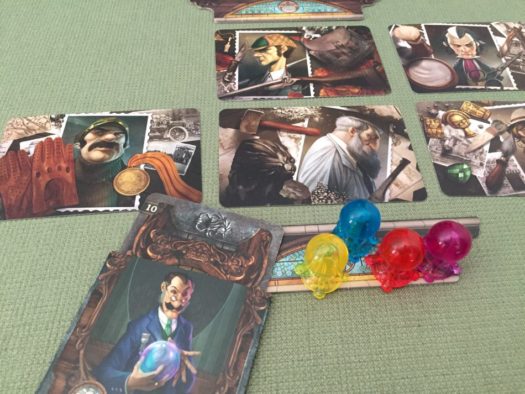
Passing Through Petra
Saturday morning started with yet another game on the Hot Games tables — Passing Through Petra by Renegade Game Studios.
While I didn’t have this game on my radar, I thought it was a pretty cool game. Those I played it with though thought even more highly of it. They left SaltCon calling Passing Through Petra as their favorite game of the con.
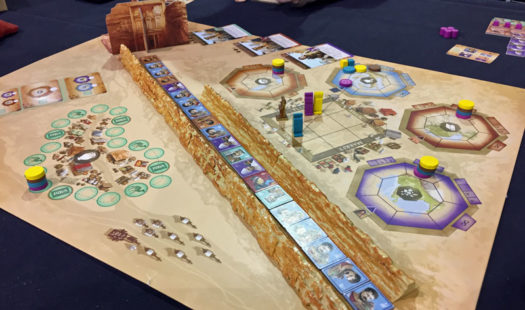
Passing Through Petra is all about trading. Not trading with other players, but trading among the types of characters in the game.
Each player has their own player board where they place character tiles. Each tile above their board trades with different colored character tiles along the bottom of their board. Players take different actions that let them slide more colored tiles along their player board — thus always shifting the power of their trading.
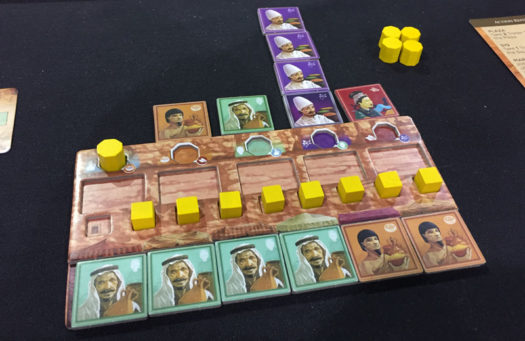
In addition to the canyon of passing traders, the central board has other colored areas where players will move their tokens in loops according to the power of their trades.
But the part I liked the most is that the central board also has a place where players choose which actions to take. The player pawns in a central square area move in the direction of the action they want to take. However, they’ll soon hit an edge and can’t go further in that direction until they move the other way. Thus, players are limited on how much they can stack their actions of a certain type.
It creates a great balance to the game of evaluating potential actions with what’s currently available.
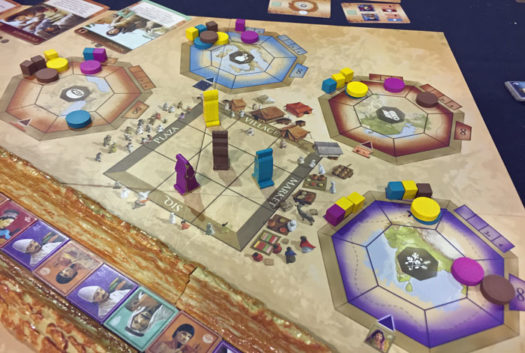
Raiders of the North Sea
While playing Architects of the West Kingdom and Champions of Midgard I’d mentioned Raiders of the North Sea a few times. Since I just reviewed it a couple weeks ago, it was fresh in my mind and I couldn’t stop comparing both of those games with Raiders.
So when I saw Raiders in the game library, I had to check it out and teach it to the friends I’d been playing with.
While I like to play new games at SaltCon, I was more than happy to teach Raiders because I enjoy the viking-themed worker placement game. And it turns out, I can now compare it to Champions of Midgard (another viking-themed, worker-placement game).
While in Raiders players build up strength and go on raids, it doesn’t really feel like battling. You just need a certain number of crew members to raid different areas. The higher strength you have will mean more potential points, but there isn’t much tension in discovering that outcome. Whereas in Champions, battles depend on dice rolling results.
So I can see the allure of both games and how they can both co-exist and be similar yet distinct.
In my book though, I’ll stick with Raiders of the North Sea.
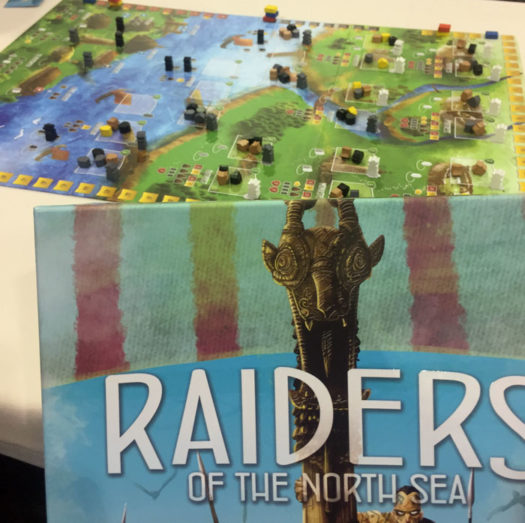
Quacks & Topiary again
After playing Raiders, I wandered around the con talking to more friends and making sure I’d picked up all my games from the SaltCon Math Trade. I also passed back through the Game Swap area and bought a couple games.
Then I met up with Dane again and introduced him to The Quacks of Quedlinberg. Since I’d enjoyed playing it before, I was more than happy to play it again.
One of the things I like about the game is that each colored token has 4 different ways it can work in the game. At the start of the game, those are randomly drawn. So one game, the blues tokens may work one way and in the next game they’ll work a slightly different way. I love that this adds to the myriad of combinations between the colors to be played. So each time you play, you’ll have to adjust how you play.
I then met up with a couple other friends and taught them how to play Topiary.
The River
The last game I played at SaltCon was also a game I’d recently reviewed. My friends had seen my review and were interested in playing The River — which they’d checked out from the Game Library (even though it was one of the Hot Games too).
The River is a good intro-level, worker-placement game with a pioneer theme.
It was a great way to end my game plays at SaltCon!
Math Trade
I guess I should mention more about the SaltCon Math Trade because that’s also one of the things I most look forward to every year.
The Math Trade gives me a chance to trade away some of the games in my collection that are less likely to be played again in our family. In return, it gives me a chance to pick up games I’m interested in and want to give a try.
This year, I put up about 35 games in the trade and 15 of them found success.
The games I came home with from the Math Trade and look forward to playing are:
- Titan Race
- 13 Clues
- Survive: Space Attack!
- Animals on Board
- Eldritch Horror
- Flick ’em Up!: Dead of Winter
- Macroscope
- Star Wars: Destiny – Two-Player Game
- Shear Panic
- Time’s Up!
- Citadels
- Charterstone
- Labyrinth
- Trainmaker
- Twist of Fate
As always, I left SaltCon a bit worn out from playing late into the night each night. But I also left wishing I could stay longer. And that’s a good sign when you’re still wanting to keep playing.
To all my SaltCon friends, I’m already looking forward to seeing you again next year!



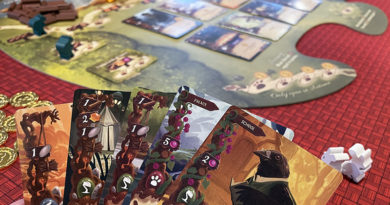
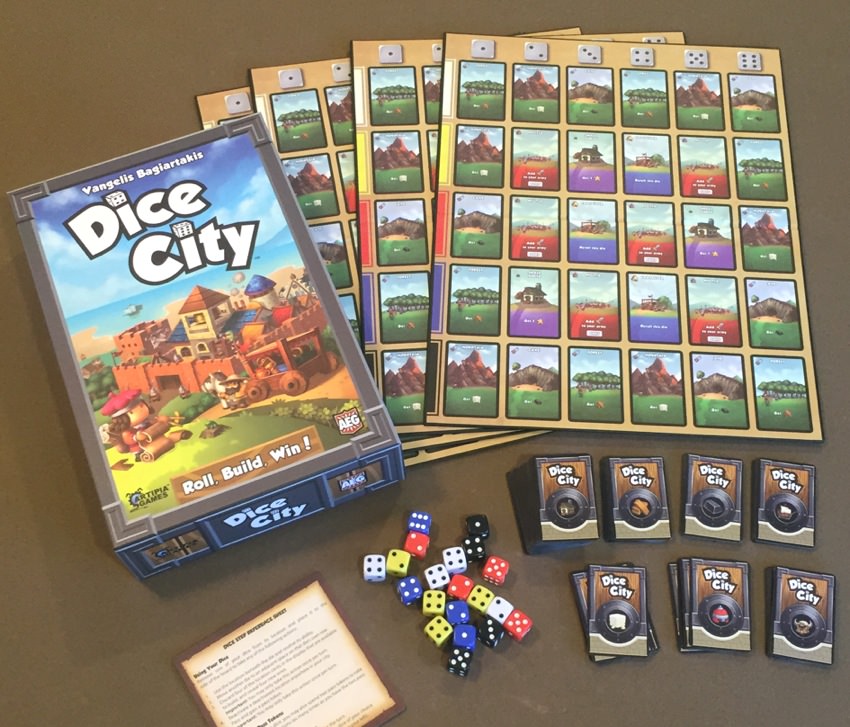
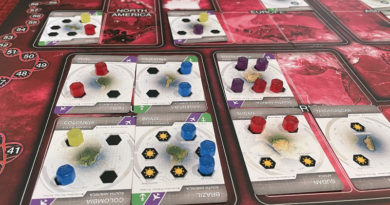
Thanks! I felt like I was right there with you! You gave me food for thought on several games I have been considering ! Enjoyed your blog
Paulspo – That’s great to hear. It’s always fun to have new games to consider.
It was a great time, thanks Trent!